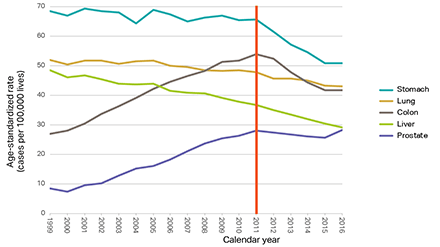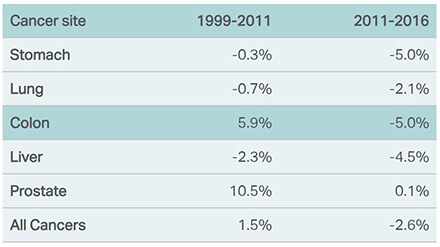Pricing critical illness (CI) insurance necessitates a view of the future, informed by trends in past disease incidence rates. One of the main CI conditions is cancer. Examples from Asia show that population incidence rates for some of the most prevalent cancers have notably improved in recent years.
Not incorporating this short- to medium-term experience in CI trend assumptions could lead to a sizeable over-estimation of future claim costs, and therefore to overpricing.
As shown in Figure One and Figure Two (see below) incidence rates for many of the most prevalent male cancers have improved, or continued to improve, after 2011 (most notably for colon and stomach cancer). A shift in incidence rates was also observed in Japan in 2011.
Colon cancer incidence deteriorated at a rate of 5.9% for more than 10 years and then improved at a trend of minus 5% since 2011. Incidence trends based on data from 1999-2011 would therefore be more pessimistic than those calculated on data from 2011-2016. For a male non-smoker aged 45, incidence trends based on 1999-2011 data would potentially overestimate the present value of future claims by 37% for stomach cancer and 120% for colon cancer.
This has a significant impact on CI pricing. For example, for South Korea, for all male cancers – an assumed arbitrary worsening trend of 1.5% instead of an improving trend of minus 2.6% for 10 years, which potentially overstates the current value of claims by 18%. A book of business/treaty last priced in 2011 could have been overpriced by 18%.

Figure One: Age-standardised population incidence rates for the most prevalent male cancers 1999-2016, South Korea. Trends notably improved after 2011. Data source: Korea Central Cancer Registry (KCCR) [1].
Will the trend continue?
Despite the observed improvements in stomach and colon cancer in South Korea, 2016 (the most recent year) data indicates a flattening. Although only one year, several risk factors indicate that improvement will continue in the short to medium term (next five to 10 years), but is likely to flatten in the long term. Factors include:
- The prevalence of Helicobacter pylori in Korean adults has fallen constantly by 1.5% per year since 1998. At the same rate, it would take another 20 years to reach western levels.
- Smoking rates are likely to continue to decline, suggesting a continued improvement given the lag between cause and effect, at least in the short term.
- If eligibility for screening and removal of pre-cancerous colon polyps widens, as is likely, and given lags of up to 10 years for polyps to become cancerous, improvements can be expected for years to come.
- The increasing discovery of early-stage male stomach cancers is an indication of earlier screening. However, given that over 70% of those eligible are already being screened, this risk factor is likely to cause a flattening in future incidence rates.

Figure Two: Empirically calculated incidence trends for the most prevalent male cancers, South Korea, using 1999-2011 and 2011-2016 population data. The two periods lead to distinctly different trend rates on which to price future CI business, adding complexity to deriving long-term incidence trends. Data source: KCCR.
Updating trend assumptions
The observations highlight the importance of regularly monitoring cancer incidence trends, understanding the evolving risk factors and updating trend assumptions. Of course, across all cancers, improving trends in some may offset worsening trends in others; in Singapore, for example, worsening incidence trends in females for breast cancer are offsetting improving incidence trends in colon and lung cancer.
It is recommended therefore that short- to medium-term trending for countries where data is available should be guided (but not dictated) by relevant, recent historic experience. This can then be blended into a long-term trend assumption that the pricing actuary considers reasonable given not just incidence data but all relevant risk factors including medical developments, lifestyle changes and screening programs.
This article is written by CJ Sadler who is a senior pricing actuary life and health at PartnerRe; he is based in Hong Kong.
Reference
-
Cybersecurity: The false promise of flawed certifications
- April 23
There is little correlation between certifications and avoiding breaches as the cybersecurity landscape evolves too quickly for annual checkups to be sufficient.
-
Trade credit: Amid trade war, APAC firms must stay agile and ensure adequate protection
- April 2
The US has implemented a new tariff regime across industries and countries, with import duties being a central aspect of US economic and foreign policy. These measures aim to protect domestic industries from what the US government perceives as unfair trade practices, global excess capacity, and imbalanced trading relationships. The policy includes mainland China, delayed […]
-
Insurtech: Tech predictions for the insurance sector in 2025
- January 27
2024 was the year we saw signs that the insurance industry is rapidly transitioning from experimenting with generative AI (GenAI) to deploying scaled production use cases. Fuelled by new data streams and advancements in IOT, and wearables, predictive capabilities are reaching new heights. However, prediction alone is insufficient to reduce loss ratios systemically; meaningful impact […]
-
2004 tsunami: Loss, and lessons: reckoning with the Indian Ocean tsunami 20 years on
- December 20
Though two decades have passed, the 2004 Indian Ocean tsunami is still fresh in my memory. I was in Australia at the time. It was a warm summer’s day, with many people starting to watch the Boxing Day test cricket match between Australia and Pakistan in Melbourne, when the news first hit. Like all of […]
-
Allianz General | Allianz General combines innovative protection solutions while powering social good to lead Malaysian market
The carrier proactively addresses emerging risks and evolving customer protection needs while giving back to the community.
-
Sedgwick | Asia’s Energy Transformation – Balancing Growth, Risk and Renewables
Energy market presents unique risks, especially in a region which includes China and Japan as well as developing nations like Vietnam and the Philippines.
-
Beazley | Turbulent Waters: the maritime energy transition challenge
Businesses are facing a complex transition to non-carbon energy sources amid a push to achieve net-zero emissions for the marine sector by 2050.
-
Aon | Navigating shifts in the global and Asia insurance markets
Neelay Patel, Aon head of growth for Asia, says the market in Asia is at an ‘interesting stage of the cycle’.


CJ Sadler, PartnerRe
The impact of improving cancer rates on critical illness pricing
CJ Sadler, PartnerRe